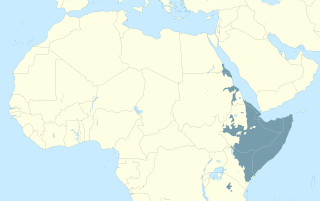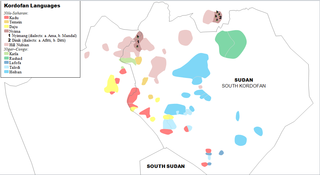Related Research Articles

The Cushitic languages are a branch of the Afroasiatic language family. They are spoken primarily in the Horn of Africa, with minorities speaking Cushitic languages to the north in Egypt and Sudan, and to the south in Kenya and Tanzania. As of 2012, the Cushitic languages with over one million speakers were Oromo, Somali, Beja, Afar, Hadiyya, Kambaata, and Sidama.
The Nubian languages are a group of related languages spoken by the Nubians. In the past, Nubian languages were spoken throughout much of Sudan, but as a result of Arabization they are today mostly limited to the Nile Valley between Aswan and Al Dabbah. In the 1956 Census of Sudan there were 167,831 speakers of Nubian languages. Nubian is not to be confused with the various Nuba languages spoken in villages in the Nuba mountains and Darfur.

Nubians are a Nilo-Saharan speaking ethnic group indigenous to the region which is now northern Sudan and southern Egypt. They originate from the early inhabitants of the central Nile valley, believed to be one of the earliest cradles of civilization. In the southern valley of Egypt, Nubians differ culturally and ethnically from Egyptians, although they intermarried with members of other ethnic groups, especially Arabs. They speak Nubian languages as a mother tongue, part of the Northern Eastern Sudanic languages, and Arabic as a second language.

Lower Nubia is the northernmost part of Nubia, roughly contiguous with the modern Lake Nasser, which submerged the historical region in the 1960s with the construction of the Aswan High Dam. Many ancient Lower Nubian monuments, and all its modern population, were relocated as part of the International Campaign to Save the Monuments of Nubia; Qasr Ibrim is the only major archaeological site which was neither relocated nor submerged. The intensive archaeological work conducted prior to the flooding means that the history of the area is much better known than that of Upper Nubia. According to David Wengrow, the A-Group Nubian polity of the late 4th millenninum BCE is poorly understood since most of the archaeological remains are submerged underneath Lake Nasser.
Nobiin, also known as Halfawi, Mahas, is a Nubian language of the Nilo-Saharan language family. "Nobiin" is the genitive form of Nòòbíí ("Nubian") and literally means "(language) of the Nubians". Another term used is Noban tamen, meaning "the Nubian language".
The Kadaru are a sub-ethnic group of the Nuba peoples in the Nuba Mountains of South Kordofan state, in southern Sudan. They live in the Kadaru Hills between Dilling and Delami in South Kurdufan.

The Nara (Nera) or Barea (Barya) language is spoken by the Nara people in an area just to the north of Barentu in the Gash-Barka Region of western Eritrea. The language is often confused with Kunama, which is at best only distantly related.

The Nyima languages are a pair of languages of Sudan spoken by the Nyimang of the Nuba Mountains that appear to be most closely related to the Eastern Sudanic languages, especially the northern group of Nubian, Nara and Tama.

Tegali is a Kordofanian language in the Rashad family, which is thought by some to belong to the hypothetical Niger–Congo phylum. It is spoken in South Kordofan state, Sudan.
Lafofa, also Tegem–Amira, is a dialect cluster spoken in the southern Nuba Mountains in the south of Sudan. Blench (2010) considers the Tegem and Amira varieties to be distinct languages; as Lafofa is poorly attested, there may be others.
Nyimang, also known as Ama, is an Eastern Sudanic language spoken in the Nuba Mountains of Sudan by the Nyimang people who are a sub-group of the Nuba people.
Afitti is a language spoken on the eastern side of Jebel el-Dair, a solitary rock formation in the North Kordofan province of Sudan. Although the term ‘Dinik’ can be used to designate the language regardless of cultural affiliation, people in the villages of the region readily recognize the terms ‘Ditti’ and ‘Afitti.’ There are approximately 4,000 speakers of the Afitti language and its closest linguistic neighbor is the Nyimang language, spoken west of Jebel el-Dair in the Nuba Mountains of the North Kordofan province of Sudan.
Dair is a moribund Hill Nubian language spoken in the northern Nuba Mountains in the south of Sudan. It was spoken by around 1,000 people in 1978 in the Jibaal as-Sitta hills, between Dilling and Delami.
Karko is a Hill Nubian language spoken in the northwestern Nuba Mountains in the south of Sudan. It is spoken by around 7,000 people in the Karko hills, 35 km west of Dilling, including Dulman, although Jakobi Angelika & Hamdan Ahma estimate the Karko population at up to 15,000 individuals, mostly in urban centers. Ethnologue reports that speakers of Karko are shifting to Sudanese Arabic.
Kadaru is a Hill Nubian language spoken in the northern Nuba Mountains in the south of Sudan. It is spoken by around 25,000 people in the Jibaal as-Sitta hills, between Dilling and Delami. Kordofan Nubian is a cluster of dialects also called Ajang Language with names of dialects varying according to specific clans. According to Ajang people, they all belong to one language group and although some sounds and words might have changed with time, they can understand each other quite well. It is closely related to Ghulfan, with which it forms the Kadaru-Ghulfan subgroup of Hill Nubian.
Dilling is a Hill Nubian language spoken in the northwestern Nuba Mountains in the south of Sudan. It is spoken by around 12,000 people in the town of Dilling and surrounding hills, including Kudur. Ethnologue reports that Dilling is moribund, with only older adults speaking the language and not using it with their children. All speakers also use Sudanese Arabic. The Dilling call themselves Warki, while the Dilling speakers of Kudur call themselves Kwashe. Another ethnic minority that speak Dilling are the Debri people, an ethnic group of several thousand people from South Kordofan in Sudan
Ghulfan is a Hill Nubian language spoken in the central Nuba Mountains in the south of Sudan. It is spoken by around 40,000 people in the Ghulfan Kurgul and Ghulfan Morung hills, south of Dilling. The villages in which the language is spoken are Dabri, Karkandi, Katang, Kurgul, Namang, Ninya, Moring, Ota, Shigda, and Tarda. It is closely related to Kadaru, with which it forms the Kadaru-Ghulfan subgroup of Hill Nubian.
Wali is a Hill Nubian language spoken in the northwestern Nuba Mountains in the south of Sudan. It is spoken by around 9,000 people 12 km northeast of Katla. Ethnologue reports that use of Wali is vigorous and that there are many monolingual speakers. Young children speak English and Wali, but it is expected that the next generation will continue to communicate using Wali.
Keiga Jirru is an Eastern Sudanic language spoken in the Nuba Hills of Sudan.
Kenzi, also known as Kenuzi, Kunuz, or Mattokki, is a Nubian language of Egypt. It is spoken north of Mahas in Egypt, and is closely related to Dongolawi or Andaandi, a Nubian language of Sudan. The two have historically been considered two varieties of one language. More recent research recognizes them as distinct languages without a "particularly close genetic relationship." With population displacement due to the Aswan High Dam there are communities of speakers in Lower Egypt. Recent linguistic research on the Kenzi language has been conducted by Ahmed Sokarno Abdel-Hafiz.
References
- ↑ Ghulfan at Ethnologue (27th ed., 2024)

Kadaru at Ethnologue (27th ed., 2024)
Karko at Ethnologue (27th ed., 2024)
Wali at Ethnologue (27th ed., 2024)
Dilling at Ethnologue (27th ed., 2024)
Dair at Ethnologue (27th ed., 2024)
(Additional references under 'Language codes' in the information box) - ↑ Jakobi, Angelika; Ruffini, Giovanni; Oei, Vincent W. J. van Gerven (2014-06-03). Dotawo: A Journal of Nubian Studies: Vol. 1: 2014. punctum books. p. 203. ISBN 9780692229149.
- ↑ "Nubian". Ethnologue. Retrieved 2017-06-24.
- ↑ "Glottolog 3.0 - Kordofan Nubian". glottolog.org. Retrieved 2017-06-24.
- ↑ "Hill". Ethnologue. Retrieved 2017-06-24.
- ↑ Rilly, Claude. 2010. Le méroïtique et sa famille linguistique. Leuven: Peeters Publishers. ISBN 978-9042922372